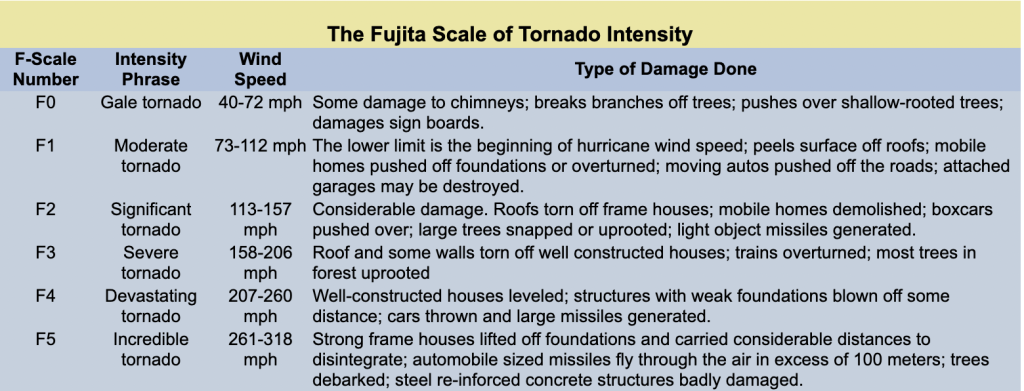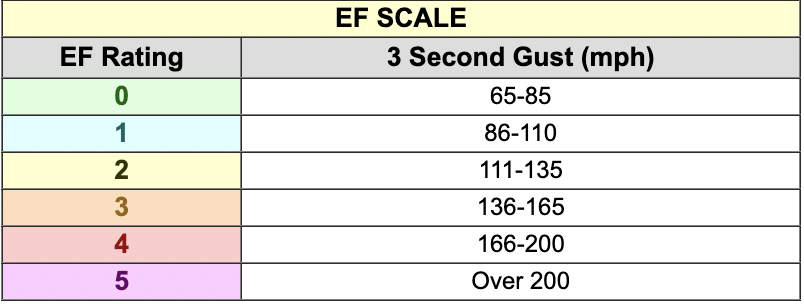Tornadoes are among the most destructive and awe-inspiring forces of nature, capable of unleashing unparalleled devastation in a matter of minutes. Understanding the intensity of these swirling vortexes has been a challenge for meteorologists for decades. Over time, various methods have been developed to categorize tornadoes, with the most notable transition occurring from the Fujita (F) scale to the Enhanced Fujita (EF) scale. Let’s delve into the evolution of these rating systems and explore the differences in the factors utilized to assess tornado intensity.
The Fujita Scale (F Scale)
In the early 1970s, Dr. Ted Fujita, a renowned Japanese-American meteorologist, introduced the Fujita Scale as a means of classifying tornadoes based on the damage they caused. The scale ranged from F0 to F5, with each category corresponding to a range of wind speeds and associated damage. For instance, an F0 tornado typically caused light damage to trees and buildings, while an F5 tornado was capable of leveling well-built homes and tossing vehicles like toys.
The F Scale primarily relied on observed damage to determine tornado intensity. Damage indicators such as trees, buildings, and vehicles were examined to estimate wind speeds, which were then matched to the appropriate F category. However, this approach had limitations, as damage patterns could vary widely depending on construction quality, terrain, and other factors.

The Enhanced Fujita Scale (EF Scale)
Recognizing the need for a more robust and scientifically grounded rating system, the Enhanced Fujita Scale was introduced in 2007. Developed by a team of meteorologists and engineers, the EF Scale builds upon the foundation laid by the original F Scale while incorporating advancements in meteorological research and engineering.
Unlike its predecessor, which relied solely on observed damage, the EF Scale takes into account a broader range of factors to assess tornado intensity. These factors include not only damage indicators but also the construction quality of affected buildings, vegetation, and soil conditions. Additionally, advancements in Doppler radar technology have enabled meteorologists to estimate wind speeds more accurately, providing valuable data for EF Scale assessments.

Key Differences in Factors Utilized
1. Damage Indicators: Both the F and EF Scales utilize damage indicators such as trees, buildings, and vehicles to assess tornado intensity. However, the EF Scale places greater emphasis on the specific types of damage observed and the degree of destruction, allowing for more precise categorization.
2. Construction Quality: The EF Scale considers the quality of construction when evaluating damage to buildings. Structures are classified into five different types, ranging from weak frame houses to well-built homes and commercial buildings. This nuanced approach helps account for variations in building standards and materials.
3. Vegetation and Soil Conditions: In addition to built structures, the EF Scale factors in damage to vegetation and changes in soil conditions caused by tornadoes. This holistic approach provides valuable insights into the intensity and path of the tornado, helping meteorologists refine their assessments.
4. Doppler Radar Data: While both scales rely primarily on observed damage, the EF Scale incorporates Doppler radar data to supplement on-the-ground assessments. Doppler radar can measure wind speeds within a tornado’s circulation, providing valuable data for estimating tornado intensity and verifying EF Scale ratings.
Conclusion
The transition from the Fujita Scale to the Enhanced Fujita Scale represents a significant advancement in tornado intensity classification. By incorporating a broader range of factors and leveraging technological innovations, the EF Scale provides meteorologists with a more comprehensive and accurate method for assessing tornadoes. While challenges remain in accurately rating tornado intensity, ongoing research and advancements in technology continue to enhance our understanding of these powerful natural phenomena.
